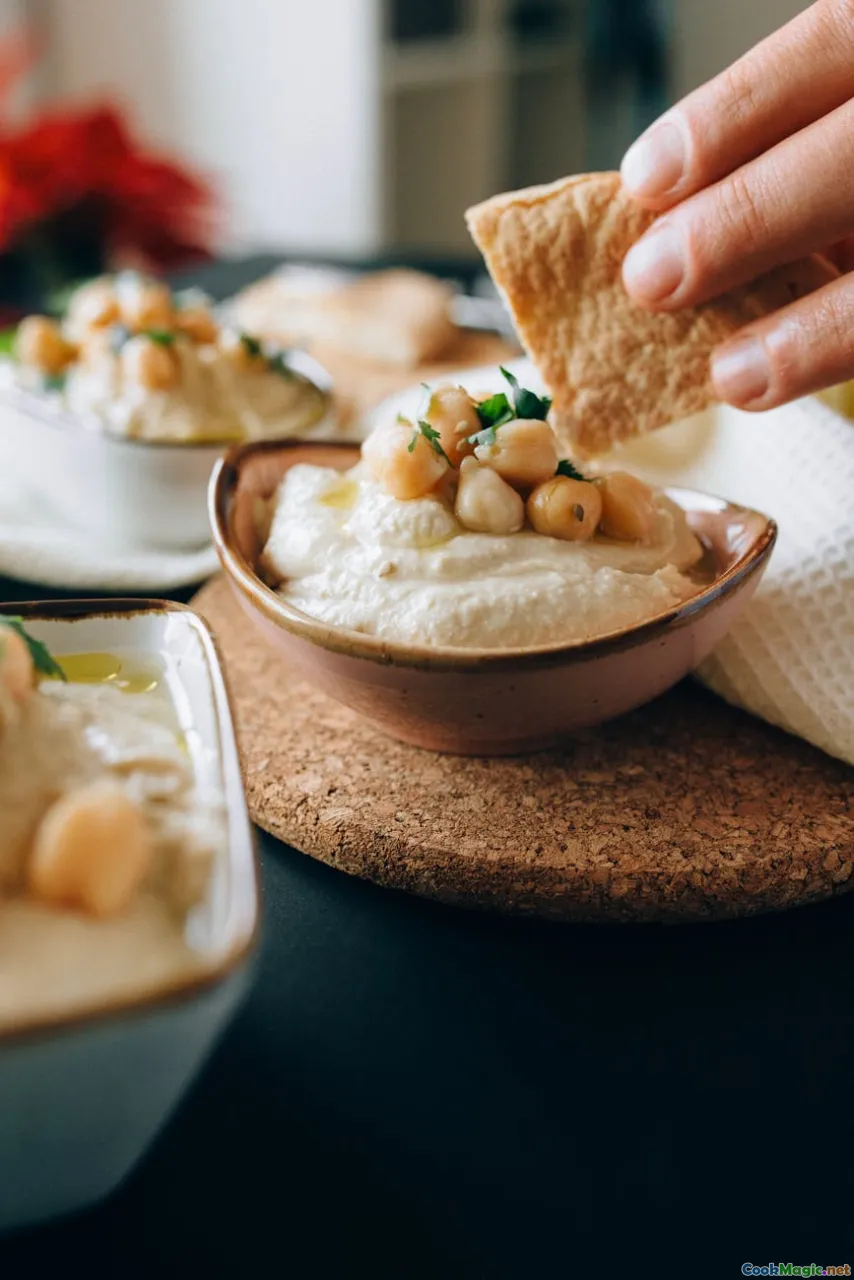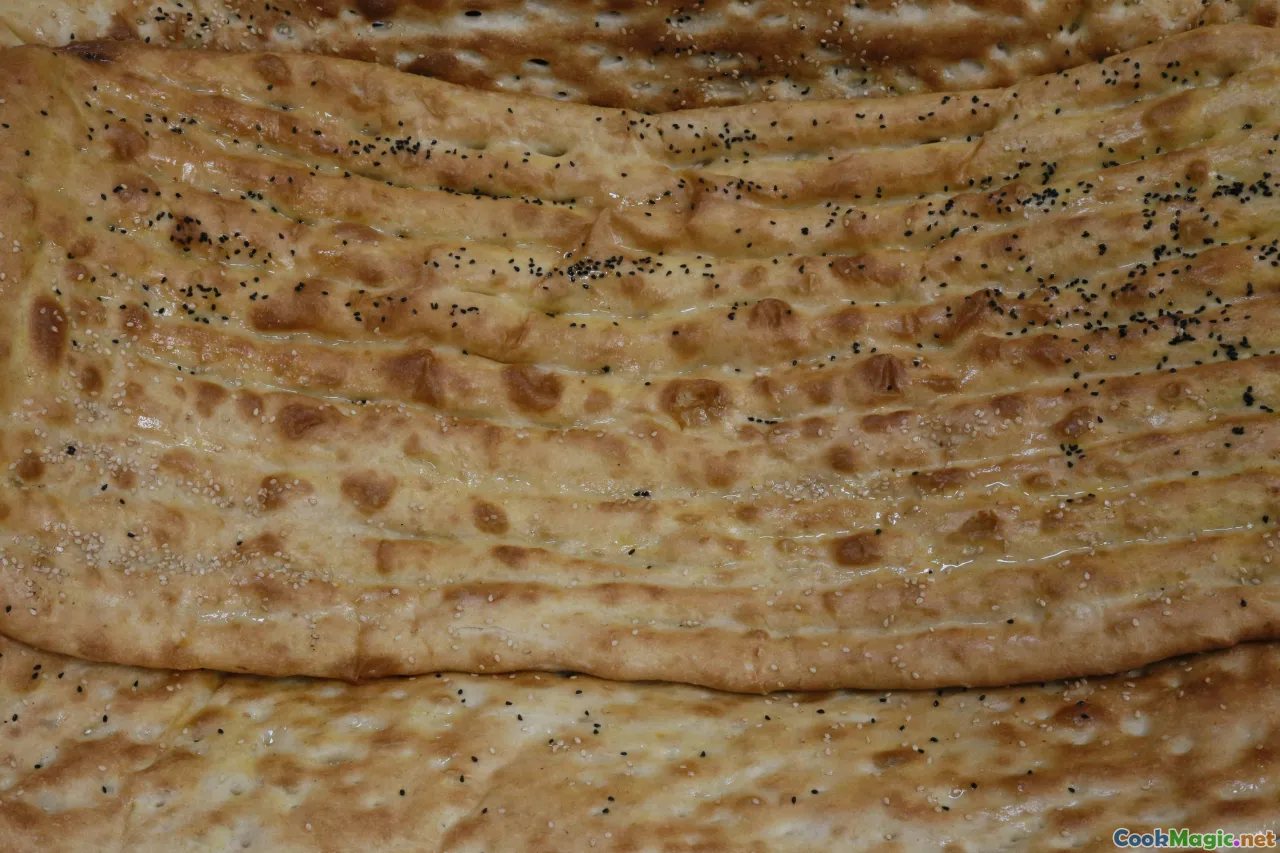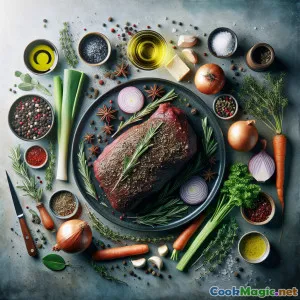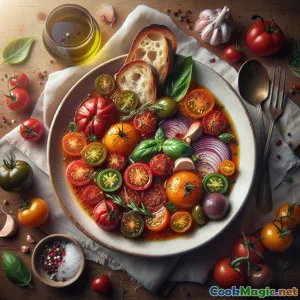
日晒Za’atar Dhayah面包:乡村风格的扁面包佳肴
(Sunbaked Za’atar Dhayah Bread: Rustic Flatbread Delight)
(0 评论)食材
营养
- 份量: 4
- 每份大小: 1个中等大小的扁面包(约130克)
- Calories: 285 kcal
- Carbohydrates: 0 g
- Protein: 8 g
- Fat: 8 g
- Fiber: 2.7 g
- Sugar: 2.9 g
- Sodium: 375 mg
- Cholesterol: 1 mg
- Calcium: 81 mg
- Iron: 2.1 mg
制作步骤
-
1 - 激活酵母:
在碗中,将酵母和蜂蜜加入温水中搅拌。让其发酵5-10分钟,直到起泡。
-
2 - 制作面团:
将面粉和盐在碗中混合。加入发酵好的酵母混合物、2汤匙橄榄油,如果使用的话,还可以加入酸奶。搅拌均匀。
-
3 - 揉至有弹性:
将面团放在撒了面粉的表面上。揉至软、光滑且有弹性,大约8-10分钟。
-
4 - 第一次发酵:
将面团放入抹了油的碗中。盖上盖子,在温暖(最好是阳光充足)的地方发酵至体积翻倍。
-
5 - 塑形扁面包:
将发酵好的面团分成四个球。擀成大约1厘米厚的圆形。
-
6 - 加入扎阿塔尔和芝麻:
将za’atar与剩余的1汤匙橄榄油混合。涂抹在每片面包上,撒上芝麻。
-
7 - 日晒或烤箱烘焙:
日光浴:将平饼放在烤盘上,放在直射阳光下15-20分钟,使其变脆。或者,在220°C(425°F)下烘烤8-10分钟,直到金黄。
-
8 - 上菜:
稍微冷却一下;趁温热时搭配额外的橄榄油、拉布尼或你喜欢的蘸酱食用。
在碗中,将酵母和蜂蜜加入温水中搅拌。让其发酵5-10分钟,直到起泡。
将面粉和盐在碗中混合。加入发酵好的酵母混合物、2汤匙橄榄油,如果使用的话,还可以加入酸奶。搅拌均匀。
将面团放在撒了面粉的表面上。揉至软、光滑且有弹性,大约8-10分钟。
将面团放入抹了油的碗中。盖上盖子,在温暖(最好是阳光充足)的地方发酵至体积翻倍。
将发酵好的面团分成四个球。擀成大约1厘米厚的圆形。
将za’atar与剩余的1汤匙橄榄油混合。涂抹在每片面包上,撒上芝麻。
日光浴:将平饼放在烤盘上,放在直射阳光下15-20分钟,使其变脆。或者,在220°C(425°F)下烘烤8-10分钟,直到金黄。
稍微冷却一下;趁温热时搭配额外的橄榄油、拉布尼或你喜欢的蘸酱食用。
关于 日晒Za’atar Dhayah面包:乡村风格的扁面包佳肴 :的更多信息
Sunbaked Za’atar Dhayah Bread: A Fusion of English Ingenuity and Middle Eastern Essence
If you’re seeking a one-of-a-kind bread—rustic, light, and aromatic—the Sunbaked Za’atar Dhayah Bread may quickly become your new favorite. Inspired by ancient Middle Eastern flatbreads and the rolling, sunlit fields of the English countryside, this recipe celebrates the best of both culinary worlds.
Historical and Cultural Roots
Flatbreads have been a staple in many global cuisines since breadmaking began. Throughout the Levant region, ‘man’oushe’ and similar flatbreads often feature za’atar, a vibrant blend of wild thyme, sumac, and sesame seeds. These breads were traditionally baked on hot stones under a searing sun—hence our ‘Sunbaked’ moniker. The twist here is an English approach: strong bread flour for structure and local olive oil, honoring artisan baking culture that’s gaining ground across the UK.
What Sets This Bread Apart?
While traditional za’atar bread relies on a wood-fired or stone oven, replicating the heat and direct sun adds not just an evocative name but a special delicacy to the crust. In true creator’s spirit, our recipe allows you to use an oven for ease, or, when blessed with a rare hot English day, you can genuinely sunbake these rounds outdoors on a safe, clean tray.
Adding a spoon of silky yogurt gives the bread tenderness, balancing the bold lemon and herbal snap of za’atar. Honey is a quiet enhancing note—often unexpected in savory baking, but gently bridging English hedgerow customs and Levantine aromas.
Culinary Tips & Serving Ideas
- Za’atar: Use the freshest available. A homemade blend (thyme, sesame, sumac, a whisper of salt) guarantees aroma and color.
- Sunbaking: Use sunlight-safe baking sheets. Avoid plastic, and move the breads out of direct sun after crust forms to cool and rest.
- Sides and Dips: Serve alongside labneh (strained yogurt cheese), hummus, or olive tapenade. Equally delicious with sharp Cheddar and fresh garden tomato—a cross-cultural picnic treat.
- Flour Matters: For a slightly heartier loaf, swap in up to 30% wholemeal.
Unique Aspects & Creative Inspiration
Baking bread under natural sunlight evokes a nostalgic sort of self-sufficiency. For home chefs, especially in parts of England that seldom see Mediterranean summers, even partial sunbaking is unexpectedly fun, bringing family or friends outdoors into the process. Kids love brushing the za’atar paste, and as the aroma curls through garden air or open kitchen windows, everyone grows even more impatient for a bite!
The za’atar itself is where you can make your mark—varying the combination can personalize your bread and allow endless seasonal permutations. Smoked or black sesame, extra sumac, or extra thyme all offer ways to experiment innocently.
Final Thoughts
Sunbaked Za’atar Dhayah Bread is a celebration of bridging gardens and cultures, equally suited for snacking with fresh herbs at an English picnic or as part of a Levantine mezze. Its sturdy crumb holds together robustly for open-faced toppings (think: roasted aubergines, tomatoes, or even sizzled eggs), or for tucking into lunchboxes or baskets.
Relatively quick to prepare (especially skipping a long proof by using milk-warm sunshine), this bread creates a moment—to linger both over the scents in your kitchen and the memory of wide fields sparkling under the same sun.
























